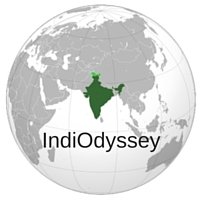I had a customer recently ask me, “what’s the difference between the dark brown lotus seed beads you sell, and the white speckled ones?”
I’ve come to learn, to satisfy my scientific self, and to remove as much doubt as possible, it is best to identify the bead/seed/wood/whatever with it’s scientific name. And while this has limitations since identification is often only by pictures and descriptions – no imperial test involved – it can help to remove much ambiguity caused by using local, generic names.
Identifying the dark brown, slightly oval seed beads commonly call lotus seed beads was easy; information and photos abound on the internet with little room for doubt, these are known by their latin, scientific name as Nelumbo nucifera. (Kamal Gatta in Hindi).
Nelumbo nucifera Gaertn.
Sacred to Hindus and Buddhists, the lotus, Nelumbo nucifera, an aquatic perennial, native from south Asia to Australia, is a symbol of divine purity. Hindu legend tells of Brahma being born from a lotus which sprang from Vishnu’s navel. The essence of Brahma is believed to be in the plant which symbolizes the idea of divine birth.
Since 200 B.C. Buddhist monuments have depicted lotuses as pedestals on which sacred beings sit or stand. The lotus personifies divine birth, the creative force and immortality. Seeds are commonly used as prayer beads. Valued as a food the in the Orient, they remain viable in mud for hundreds of years.
The other white speckled “lotus seed beads” required a lot more detective work, researching, cross referencing and calculated deducing.
First stop, let’s consider the “Bodhi seed” because, when you google lotus seed beads, you will see these white speckled beads turn up as Bodhi seeds, so that’s where I started. Bodhi beads are Buddhist prayer malas that are used for counting while reciting a mantra. And while the Chinese word for bodhi beads means Bodhi Tree (Ficus religiosa), bodhi beads are not made from the Bodhi tree. Bodhi seed does not refer to any particular plant but rather to seeds and fruits of various plants used to make prayer beads. In fact, one Chinese study identified fifty-two types of Bodhi beads.
So, a search of Bodhi seeds turns up a whole variety of beads and malas as would be expected after reading the Chinese study, and the white speckled ones are there as well. If you follow enough tangents through the web, eventually you arrive at another, less common name for the white speckled beads – “Star and Moon” Bodhi seeds, along with the Lotus seed beads, more often than any other name.
A little more cross reference sleuthing and the scientific name comes bubbling to the surface like an Alka-selzer tab…
…Daemonorops jenkinsiana,
Also called Lotus seed, Lotus Root, Linen Nut, Tropical lotus, Bodhi seeds and rattan seeds.
The beads are very hard and dense. The small holes on the beads are called moons and the tiny black spots coving the surface are called stars. They are seeds with the high density of a resin and the wood-like inside texture is solid and dense, and are in the rattan family. They are sometimes dyed brown.
So, while lotus seed beads (Nelumbo nucifera) and “Star and Moon” beads (Daemonorops jenkinsiana) can both be called bodhi seeds and lotus seeds by popular and local names, they are completely different seed beads from completely different plant families as evident by the scientific names.
There you have it!! Another mystery solved through science!!
Did this help clear things up for you? Did you ever wonder why, when you google “lotus seed beads”, both the dark brown and white speckled beads show up?
Thanks for reading and I hope you learned something of value today!




Your post is very nice thanks for sharing this post..
Thanks for reading. Glad you enjoyed it!
Hi would love to buy some of your “Star and moon” lotus seed beads please!! Your article was very helpful, thank you!
Hi Natalie,
So glad you found this article useful! Unfortunately, we do not carry the “Star and Moon” Lotus seed beads as a supply. We have a few “Star and Moon” Lotus seed malas available for sale, but that’s all. Thanks again!
Thank you for your response. I am not seeing them on your website, can you give me the link? Thanks!!
A few last questions… as I am looking at other black and white lotus seed beads online, I noticed some of them have extra holes in them, is this normal for them or a fault from drilling? And I understand that they are two different lotus but are the brown ones a different part of the plant?
Thanks!
Or I guess what I am missing is why they are both considered lotus seed beads but are not both lotus?? Sorry I have been trying to find the difference for the last week for a friend and just having my mind boggled!!! Thanks
Hi Natalie,
It would be perfectly natural for various amounts of holes in the “Star and Moon” Lotus seed beads since they are all made by Mother Nature. We currently have one for sale: https://indiodysseyshop.com/collections/malas/products/moon-and-stars-bodhi-seed-mala . But we do have a few more in stock, just not listed. The brown Lotus seeds and the “Star and Moon” Lotus seeds are from completely different plants – not even related in any way. Hope this helps! Thanks again for reading and commenting on our blog post!
So why are they called lotus seed beads at all? Lol. Thanks for your help. I appreciate your blog as there is very little info out there!! Your mala is beautiful, I will keep it in mind! Thanks
Thanks! I know, it confused the heck out of me, too! That’s why I did some digging and research to try to get to the bottom of it. Right now I’m researching the difference between red, green, white and black Sandalwood!! Another confusing trail!